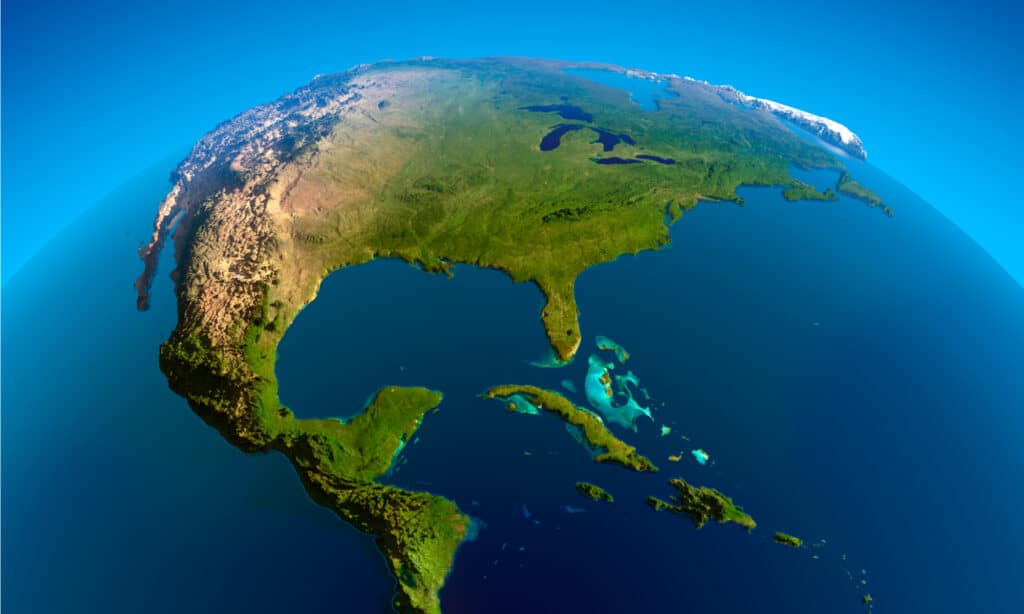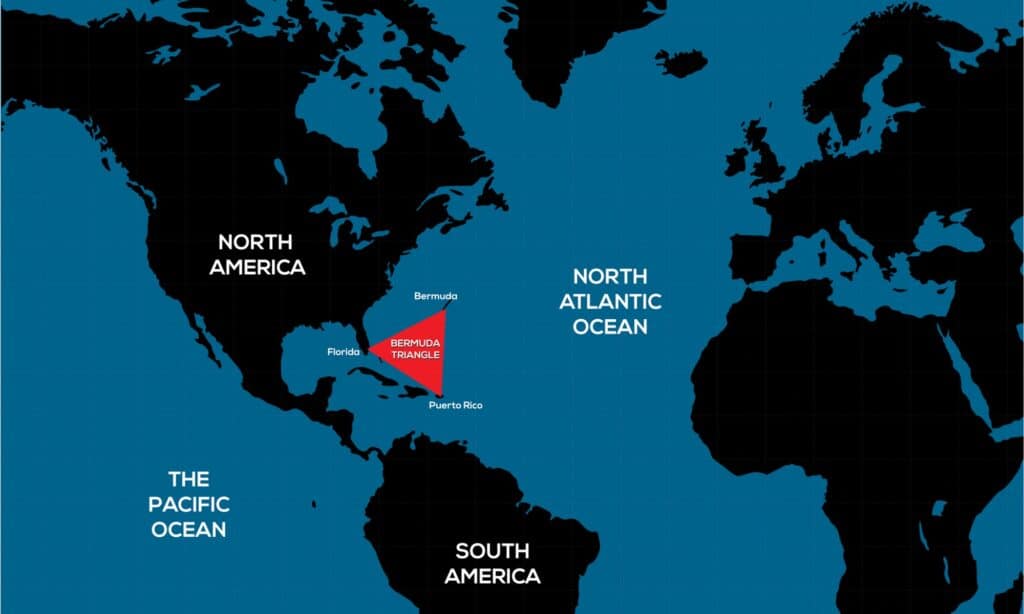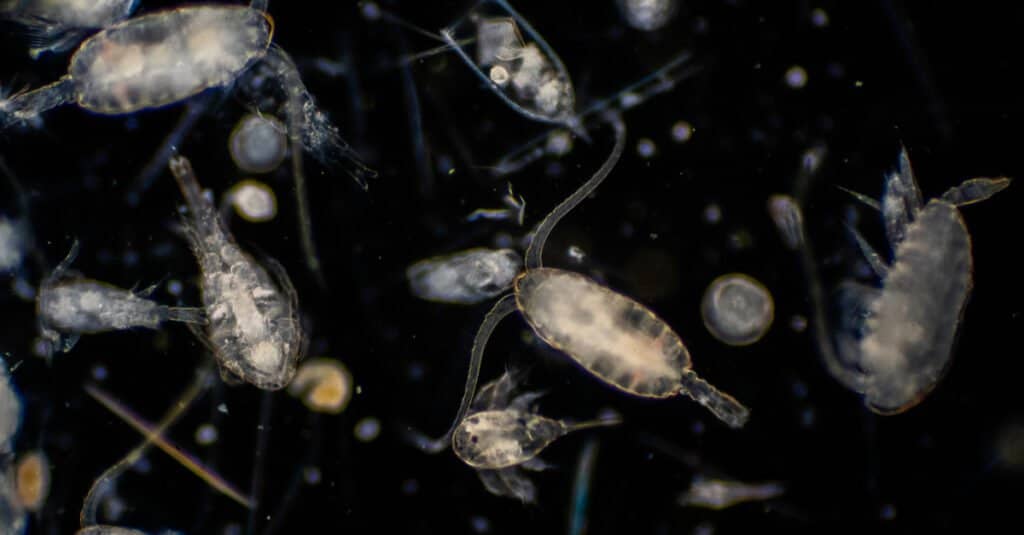December 5, 1945, five Navy planes took off from Fort Lauderdale on a routine training mission. Mission control lost contact with the pilots after two hours, and when they didn’t return after five hours, a search and rescue aircraft with a 13-man crew went looking. It was never heard from again. To this day, no one has ever found the wreckage or the bodies from the squadron. And thus, the legend of the Bermuda Triangle began.
If you’ve ever heard about this mysterious section of the Atlantic Ocean, you may wonder what lives at the bottom of the Bermuda Triangle. Discover whether its waters hold unknown creatures and if the stories are true.
What is the Bermuda Triangle?

The Bermuda Triangle is a section of the North Atlantic Ocean where numerous ships and planes mysteriously vanished.
©Anton Balazh/Shutterstock.com
The Bermuda Triangle, or the Devil’s Triangle, is an imaginary section of the North Atlantic Ocean where numerous ships and planes have vanished without a trace. The area comprises more than 500,000 square miles and forms a triangle from Bermuda to Florida to Puerto Rico. Officials consider the site “imaginary” because they do not recognize it as an official place or keep a file on it.
While the Bermuda Triangle didn’t start to earn its reputation in modern times until the 1950s, early travelers nicknamed this famous area “The Devil’s Islands.” Sailors were terrified of the reefs around Bermuda, and even Shakespeare spoke of shipwrecks and sorcery in The Tempest.
The earliest known story of the Bermuda Triangle came from Christopher Columbus in 1492. Over 500 years later, ships and planes continue to go missing, and the mystery abounds.
What is the Legend of the Bermuda Triangle?
When Columbus sailed through this stretch of sea, he kept a record of abnormal findings. He recalls his compass acting strangely, weird lights in the sky, and a fireball crashing into the ocean. Other ships like the Mary Celeste, whose whole crew vanished, were also attributed to this cursed sea.
The USS Cyclops, one of the largest ships in the US Navy, vanished into thin air in 1918. The ship carried a 306-men crew as it traveled from Brazil to Barbados. Something terrible happened during their 9-day journey, but they did not send a single SOS. No one ever found the large crew or their ship. The last message sent from the team simply stated, “Weather fair, all well.”
Over 50 ships and 20 aircraft have disappeared without a trace as they traveled through the bizarre Bermuda Triangle. Throughout the years, people have blamed these disappearances on many things, including alien abduction, Atlantis, sea monsters, and time warps. Is the Bermuda Triangle the work of something sinister, or is there a scientific explanation?
Is There an Explanation For These Strange Events?

Scientists blame extreme weather and human error for the Bermuda Triangle disappearances.
©iStock.com/GEMINI PRO STUDIO
While no explanation is concrete, scientists believe extreme weather, poor engineering, and human error are to blame for the Bermuda Triangle disappearances.
This triangular area within the Atlantic Ocean frequently encounters hurricanes. Combined with the Gulf Stream (a strong ocean current) on the western edge, these powerful storms can create waves three times taller than a normal wave. Unpredictable Caribbean storms can also produce water tornadoes that wreak havoc on ships and planes.
If these weather conditions aren’t bad enough, this area is home to some of the deepest underwater trenches in the world. A giant wave could capsize a large ship and sink it to the bottom of a channel, miles below the surface.
Even though researchers are convinced this slice of the ocean is no more mysterious than the rest, it’s still somewhat of a puzzle to figure out what happened during these unfortunate incidences.
Has anyone ever explored this part of the sea, and if so, what lurks beneath the bottom of the Bermuda Triangle?
What Lives at the Bottom of the Bermuda Triangle?

Zooplankton, jellyfish, and tiny squid live at the bottom of the Bermuda Triangle.
©Choksawatdikorn/Shutterstock.com
Gelatinous zooplankton, shrimp-like creatures, tiny squid, and pulsing jellyfish live at the bottom of the Bermuda Triangle. This part of the sea is also home to coral reefs, cookie-cutter sharks, crustaceans, and many fish species.
While many people believe the depths of Bermuda hold dangerous secrets, the truth is that it’s not unlike most places in the ocean. Its treacherous ring of coral reef makes it hazardous for ships to pass through this area, and deep ocean trenches are excellent hiding spots for ship and plane wreckage. Missing vessels suspected of being swallowed by the triangle are sometimes spotted outside the area, like in the case of the SS Cotopaxi, which divers found off the coast of St. Augustine, Florida. At the same time, others are visible on the sea floor near Bermuda.
But like with most of the ocean, the waters of the Bermuda Triangle are still vastly unexplored. In the early 2000s, a research crew conducted a 20-day deep-sea survey of the triangle region. The team collected over 1,000 different organisms, including several new species like unusual worms and zooplankton. The scientists completed their research trip without incident. Many people scuba dive and snorkel in this region and can even swim among ship wreckage.
Interesting Facts About the Bermuda Triangle
- Compasses behave strangely in the Bermuda Triangle because it is one of the few places on earth where a compass points to true north rather than magnetic north. Vessels can easily find themselves off course.
- Most of the strange disappearances occurred between 1945 and 1965.
- The deepest point in the Atlantic Ocean is within the Bermuda Triangle. The Puerto Rico Trench reaches a depth of 27,493 feet.
- Waves within the triangle can reach up to 100 feet.
- Large pockets of methane gas in this area can cause a ship to sink to the sea floor. Sediment would quickly cover the wreckage, essentially camouflaging it.
- Could the disappearances come down to statistics and probability? The Bermuda Triangle is a highly trafficked route for amateur pilots and sailors.
- Planes and ships pass through the Bermuda Triangle daily without any issues. Researchers have also confirmed there are no more incidents in the area than in any other part of the busy ocean.
The photo featured at the top of this post is © iStock.com/GEMINI PRO STUDIO
Thank you for reading! Have some feedback for us? Contact the AZ Animals editorial team.






